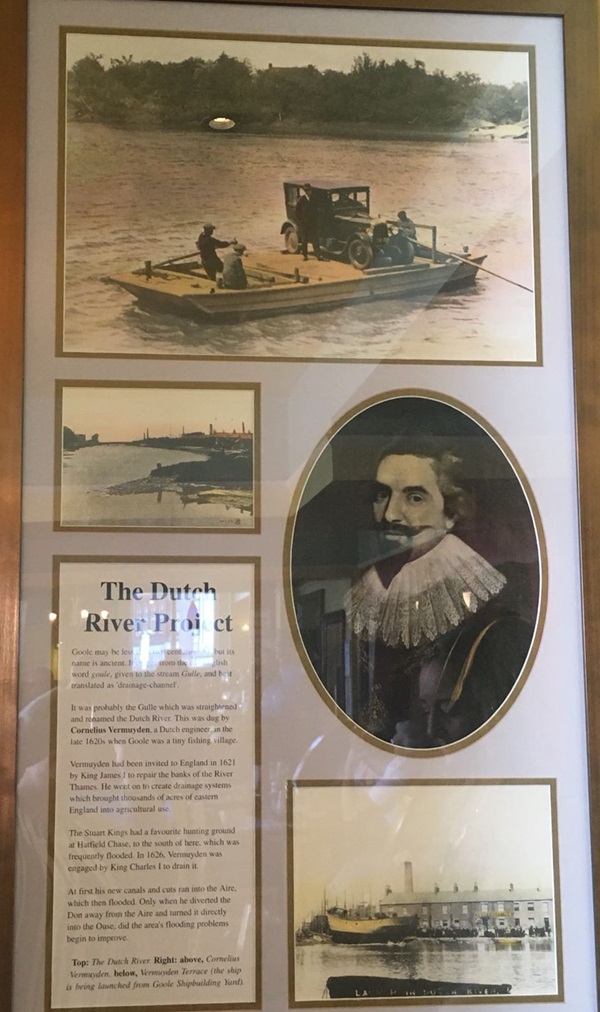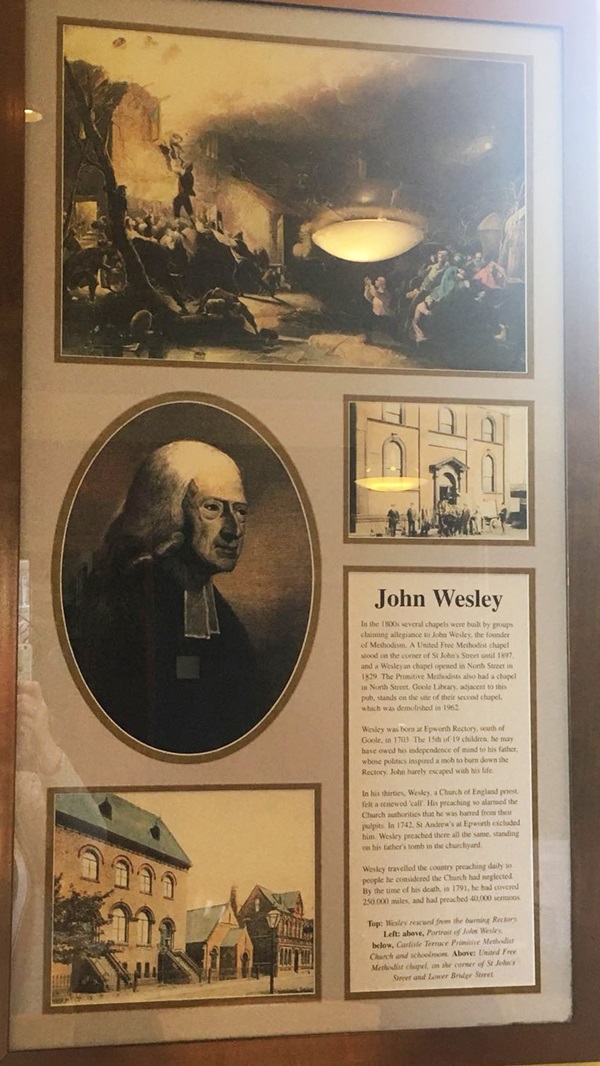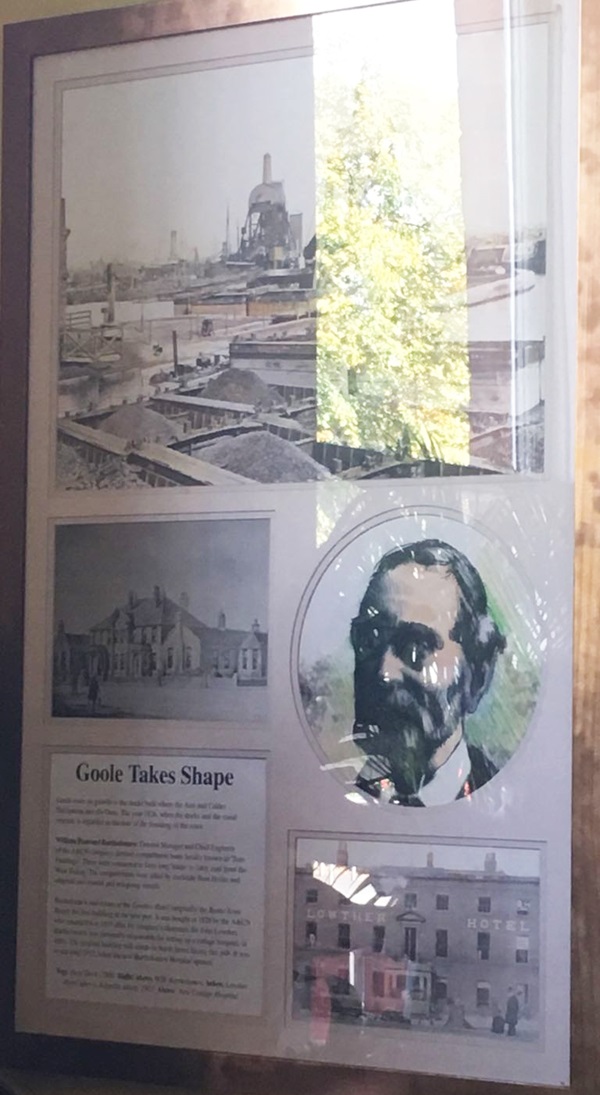The land was owned by William the Conqueror, whose son, later King Henry I, is thought to have been born in Selby in the previous year.
Howden, to the north, was famous for its Horse Fairs. It became home to the Airship Guarantee Company. The airship R38 was based at Howden during trials for the US Navy. In 1921, flying over Hull, it exploded, killing almost all of the 49 people aboard.
Top: Selby Abbey
Above: Goole Coat of Arms
Left: R38 leaving its shed at Howden, 24 August, 1921.
Prints and text about the Dutch River Project.

The text reads: Goole may be less than two centuries old, but its name is ancient. It comes from the old English word goule, given to the stream Gulle, and best translated as drainage-channel.
It was probably the Gulle which was straightened and renamed the Dutch River. This was dug by Cornelius Vermuyden, a Dutch engineer, in the late 1620s when Goole was a tiny fishing village.
Vermuyden had been invited to England in 1621 by King James I to repair the banks of the River Thames. He went on to create drainage systems which brought thousands of acres of eastern England into agricultural use.
The Stuart Kings had a favourite hunting ground at Hatfield Chase, to the south of here, which was frequently flooded. In 1626, Vermuyden was engaged by King Charles I to drain it.
At first his new canals and cuts ran into the Aire, which then flooded. Only when he diverted the Don away from the Aire and turned it directly into the Ouse, did the area’s flooding problems begin to improve.
Top: The Dutch River
Right: above, Cornelius Vermuyden, below, Vermuyden Terrace (the ship is being launched from Goole Shipbuilding Yard).
Prints and text about John Wesley.

The text reads: In the 1800s several chapels were built by groups claiming allegiance to John Wesley, the founder of Methodism. A United Free Methodist chapel stood on the corner of St John’s Street until 1897, and a Wesleyan chapel opened in North Street in 1829. The Primitive Methodists also had a chapel in North Street. Goole Library, adjacent to this pub, stands on the site of their second chapel, which was demolished in 1962.
Wesley was born at Epsworth Rectory, south of Goole, in 1703. The 15th of 19 children, he may have owed his independence of mind to his father, whose politics inspired a mob to burn down the Rectory. John barely escaped with his life.
In his thirties, Wesley, a Church of England priest, felt a renewed call. His preaching so alarmed the church authorities that he was barred from their pulpits. In 1742, St Andrew’s at Epworth excluded him. Wesley preached there all the same, standing on his father’s tomb in the churchyard.
Wesley travelled the country preaching daily to people he considered the church had neglected. By the time of his death, 1791, he had covered 250,000 miles, and had preached 40,000 sermons.
Top: Wesley rescued from the burning Rectory
Left: above, Portrait of John Wesley, below, Carlisle Terrace Primitive Methodist Church and schoolroom
Above: United Free Methodist chapel, on the corner of St John’s Street and Lower Bridge Street.
A print of the River Ouse.

Prints and text about Goole taking shape.

The text reads: Goole owes its growth to the docks built where the Aire and Calder Navigation met the Ouse. The year 1826, when the docks and the canal opened, is regarded as the date of the founding of the town.
William Hamond Bartholomew, General Manger and Chief Engineer of the A&CN company, devised compartment boats locally known as Tom Puddings. These were connected to form long trains to carry coal from the West Riding. The compartments were lifted by dockside boat hoists and emptied into coastal and sea-going vessels.
Bartholomew had rooms at the Lowther Hotel (originally the Banks Arms Hotel) the first building of the new port. It was bought in 1828 by the A&CN who renamed it in 1835 after the company’s chairman, Sir John Lowther. Bartholomew was personally responsible for setting up a cottage hospital, in 1891. The original building still stands in North Street facing this pub. It was in use until 1912, when the new Bartholomew Hospital opened.
Top: Ouse Dock c1900
Right: above, WH Bartholomew, below, Lowther Hotel after a Zeppelin attack, 1915
Above: New Cottage Hospital.
External photograph of the building – main entrance.

If you have information on the history of this pub, then we’d like you to share it with us. Please e-mail all information to: pubhistories@jdwetherspoon.co.uk